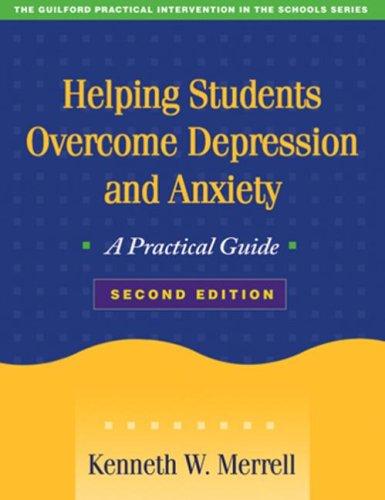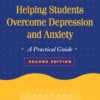Depression, anxiety, and other internalizing disorders can have severe and lasting consequences for children and adolescents. This unique book provides clear-cut strategies for addressing these problems creatively and effectively with students in grades K-12.
A concise overview of the nature, development, and course of childhood depression and anxiety is delineated, and a comprehensive assessment model is outlined. Chapters then present a wide range of empirically supported interventions that are easy to implement and readily adaptable to diverse settings. Cognitive-behavioral and psychoeducational techniques are described in jargon-free language, and numerous reproducible handouts, worksheets, and exercises are included. Other topics covered include currently available psychiatric medications for depression and anxiety, and when and how a psychiatric referral should be made.
Book Reviews
“An exceptionally useful book. Merrell cuts directly to the essential points – what internalizing disorders are, how they can best be recognized and assessed, and which specific interventions work. . . . An excellent resource for practitioners and trainers, this is also an appropriate text for courses in child counseling and therapy, cognitive-behavioral therapy, and school-based interventions.”
—Harriet Cobb, EdD,
James Madison University
“Childhood internalizing disorders often do not receive as much attention as they should, particularly in school settings. Dr. Merrell’s text provides a welcome response to this problem. . . . A unique and invaluable resource.”
—David N. Miller, PhD, University at Albany
State University of New York
“This manual provides a well-integrated compendium of successful treatment approaches. Filling a major need, this is a valuable resource for school psychologists, social workers, school counselors, and mental health professionals.”
—Paula Freer, MSW, PhD,
Coordinator of Psychological Services,
Troup County, GA, Public Schools
“This well-written, reader-friendly book blends Merrell’s research expertise in the area of childhood internalizing disorders with his sensitivity as a clinician. The discussion of real issues and situations that occur when therapy is conducted in the school setting makes this an important resource. Graduate students learning to do therapy and school-based practitioners looking to help youth suffering from anxiety or depression will benefit from reading this book.”
—Jeff Laurent, PhD, Illinois State University
Acknowledgments
About This Series
About This Book
Index of Intervention Programs and General Intervention Strategies, with Descriptions of Purpose and Developmental Level
List of Specific Treatment Techniques for Depression and Anxiety, Grouped by Program Component
- Understanding Depression and Anxiety in Children and Adolescents
- What Are Internalizing Disorders?
- Four Types of Internalizing Disorders
- Overlap of Internalizing Problems
- Students with Internalizing Problems: Three Case Studies
- How Depression and Anxiety Develop and Are Maintained
- Development of Internalizing Problems
- Do Specific Influence Require Specific Interventions?
- The Course of Internalizing Problems: Stability and Persistence
- Consequences of Internalizing Problems
- Complications: Sorting Out Related Problems
- Guidelines for Assessment and Intervention Planning
- What Are the Purposes of Assessment?
- A Model for Designing Assessments
- Recommended Assessment Methods
- Linking Assessment to Intervention
- From Assessment to Treatment Planning
- Comprehensive Intervention Program for Depression
- Four Comprehensive Intervention Programs
- Which Program Is Best?
- Modifying or Designing Your Own Comprehensive Treatment Program for Depression
- Changing Thoughts and Beliefs: Cognitive Therapy Techniques for Depression
- Cognitive Therapy for Depression: An Introduction
- Step 1: Developing Awareness of Emotional Variability
- Step 2: Detecting Automatic Thoughts and Identifying Beliefs
- Step 3: Evaluating Automatic Thoughts and Beliefs
- Step 4: Changing Negative Automatic Thoughts and Maladaptive Beliefs
- Changing Thoughts and Beliefs: Rational-Emotive Therapy, Attribution Retraining, Learned Optimism, and Journal-Writing Strategies for Depression
- Disputing Irrational Thoughts: The RET Approach
- Self-Monitoring and Self-Control Training
- Attribution Retraining and Learning to Be Optimistic
- Writing It Down: Journal Writing as an Intervention Tool
- Behavior Change, Emotional Education, Interpersonal Problem Solving, and Conflict Resolution Strategies for Depression
- Behavioral Interventions for Depression
- Emotional Education
- Interpersonal Problem Solving and Conflict Resolution Training
- Social Skills Training
- Behavioral Treatments for Anxiety: Systematic Desensitization
- Overview of Systematic Desensitization
- Other Behavioral Interventions
- Social Skills Training and Other Cognitive-Behavioral Treatments for Anxiety
- Self-Control Training for Anxiety
- Self-Instructional Training
- The “Coping Cat” Program for Anxious Youth: An Innovative, Comprehensive Treatment Approach
- The Transfer of Control Approach
- Social Skills Training
- Finding More Help: Referral Guidelines for Mental Health Counseling, Psychiatric Medications, and Alternative Treatments
- Making Referrals for Mental Health Counseling and Psychiatric Medications
- Using Medications to Treat Children’s Social-Emotional Problems: Some Basic Issues and Concerns
- Medications for Treatment of Depression
- Medications for Anxiety-Related Problems
- Alternative Interventions
App.: Reproducible Worksheets
References
Index


